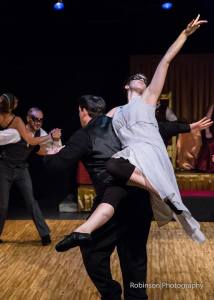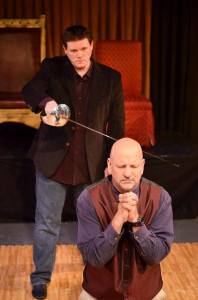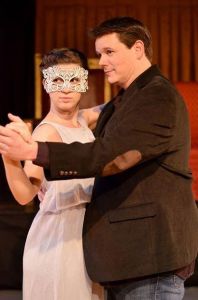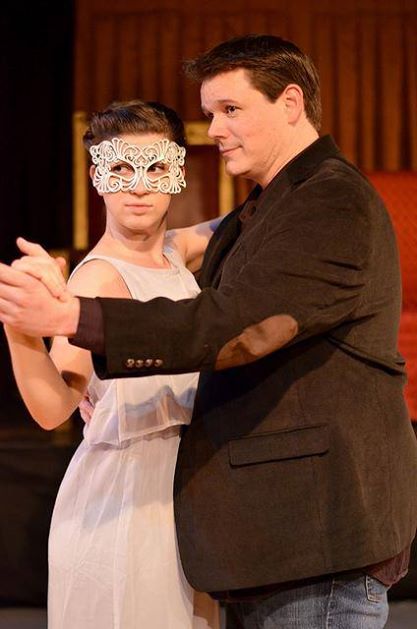Everybody lies. Shakespeare was teaching it long before House. In a newly adapted physical translation of the Bard’s greatest tragedy, Off the Quill presents their interpretation of Hamlet: Believe None of Us. Fully formulating the quote of “oh what tangled webs we weave when we practice to deceive,” this new dance-based performance has all of the recognizable quotes and characters but with a few major plot altering elements that may leave you questioning what exactly happened to the crowned Prince of Denmark. Developed by Patrick Mullen and Michael J. Dombroski, this curious new approach to Shakespeare’s bloody disasters will turn your mind upside down.
Developers Patrick Mullen and Michael J. Dombroski have taken the concept of Hamlet and evolved it into something smacking of modern crime-detective drama. The production itself is very cinematic in essence, every major dramatic moment underscored with music, even during emotionally charged soliloquies. This is an intriguing concept that works really well in some places but detracts in others. The songs are mostly modern or popularly recognized tunes, with their vocals deconstructed from the song so that only a strings rendition of the melody remains. Several draw poignant emotions together when they underscore the scenes, like Lorde’s “Royales” featured during Laertes’ advice speech to Ophelia before his departure and Lady Gaga’s “Bad Romance” that arises as an introduction to the players. On the whole the concept does serve the play rather than detract from it, again bringing a cinematic feel to the performances.
Mullen and Dombroski treat the text as guidelines for their visual constructions. It is about what is seen, not what is said. This too bridges a gap between live theatre and what one might experience in film. The subtle engagement of Hamlet to Ophelia during the opening ballroom celebration of Gertrude and Claudius’ marriage, or stooping at King Hamlet’s coffin and scraping evidence from his corpse during Hamlet’s main soliloquy; these seen gestures that occasionally accompany no text at all are what makes the play radically different from other productions. For fear of spoilers, there cannot be an explanation of all such moments, but several major moments of this style alter the events of Shakespeare’s work drastically— including the ending; and while execution and functionality of this device is impressive, those true to the Bard may leave unsettled seeing the courses of life and death altered in this fashion.

The Choreography is beyond impressive. Kathleen Moors and Diane Samuelson serve as the shows two Choreographers, working dance routines and fluid movement in at every turn, fully threading the concept of movement based emotions throughout the performance. Ophelia’s drowning becomes an ensemble number where human bodies become waves and water in a mesmerizing ebb and flow of motion. Samuelson and Moors lay out a ballerina’s routine for her alone in her chamber when Hamlet “interrupts her sewing.” But the intense acrobatics that are worked into the routines for the Players’ arrival is where the spectacle meets the physical in this show. Moors and Samuelson make the show lively and unique with where they choose to infuse dance into the text, sometimes replacing it entirely, as they do with the gravedigger’s argument.
Costumer Katie Wanschura crafts an elegant modernity with a hint of classic Renaissance into her threadwork for the show. The black and white masquerade costumes for the opening nuptial celebration is offset to perfection with the glimmering crimson reserved for the new king and queen. Hamlet is always wrapped in a long brown coat which pays homage to some modern fantasy detective/crime solving television show; little things like this keep the audience guessing about the exact location and time of the production, but it serves to add to the air of mystery that is suffused throughout.
Director Patrick Mullen makes fascinating choices outside of the physical interpretations and changes made to the flow of the plot. Casting Rosencrantz (Shannon Riley) and Guildenstern (Meredith Coyle) as sensual femme fatales is a brilliant move, but falls short in its delivery. Keeping the lines the same, the way they play with Hamlet and interact with Gertrude could be taken much further to really drive home the notion of making them seductresses. Gertrude (Katie Wanschura) also falls short in her performance, bland and detached during the otherwise intense and frightening encounter with Hamlet in her bedchamber.

Polonius (Donald R. Cook) and Claudius (William Cassidy) have a remarkable handle on how to deliver Shakespeare. Cook’s approach to the character of Polonius is like many, an overly protective father that cannot do enough to keep his precious daughter safe. There are moments of spastic eruption in his portrayal that seem to arise from nowhere, but if it is madness there is method to it and ultimately it makes for an amusing interpretation. Cassidy as the villainous king has a slow deliberate delivery of his lines which makes him vile and unctuous beyond compare. There is a fascinating and almost enigmatic air to his presence on the stage; but the most striking moment of his performance is his utter breakdown over the casket of King Hamlet in confession. The raw emotions that come gushing forth are striking and yet so jarring that it is still impossible to feel pity for him.

Off her rocker or desperately in love Ophelia (Chelsie Lloyd) makes for the perfect foil to Hamlet (Michael J. Dombroski) in this production. Her reckoning of madness is thoroughly disturbing in both a physical and emotional capacity and the fact that she never once showed signs of mental instability leading up to that point makes the transition that much more harrowing to accept. Though her stage time is brief, her impact is felt like shuddering ripples across the smooth pond. Dombroski delivers a strong rendition of Hamlet. There is no madness present in his portrayal, only deception, which fits the directional choices exceptionally well. Anger and frustration are the chestnuts in his arsenal and he puts them to good use without feeling trite. It’s the minutia of moments that will need to be examined closely to thoroughly enjoy his interpretation of the character; the off-handed comment to Horatio before engaging fence-combat with Laertes or the encounter with the ghost of King Hamlet early in the production.
The closest thing Hamlet has seen to a television mini-series is what’s unfolding on the stage in this performance, but many of the performance tangled up in this web of lies make it truly compelling and well worth viewing, which is more than can be said for most of what ends up as passable on television these days.
Running Time: 2 hours and 50 minutes with one intermission
Hamlet plays through October 12, 2014 at Off the Quill playing at the Greenbelt Arts Center— 123 Centerway in historic Greenbelt, MD. For tickets call the box office at (301) 441-8770 or purchase them online.

